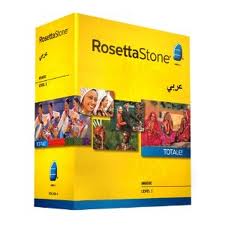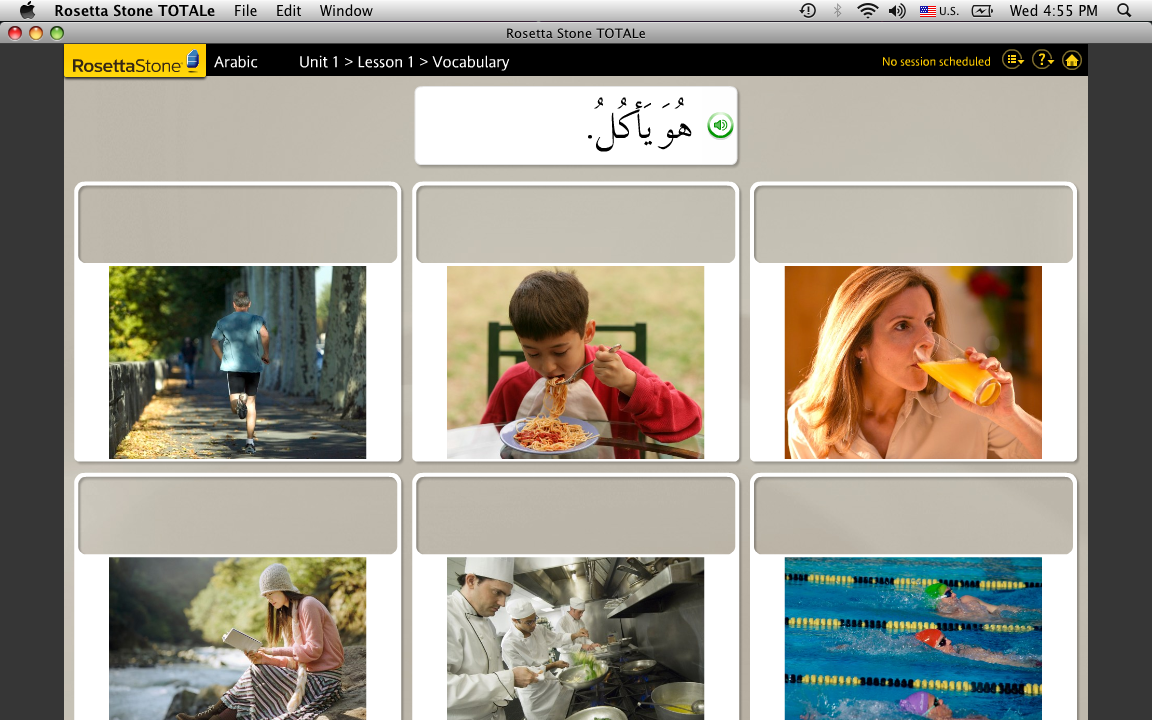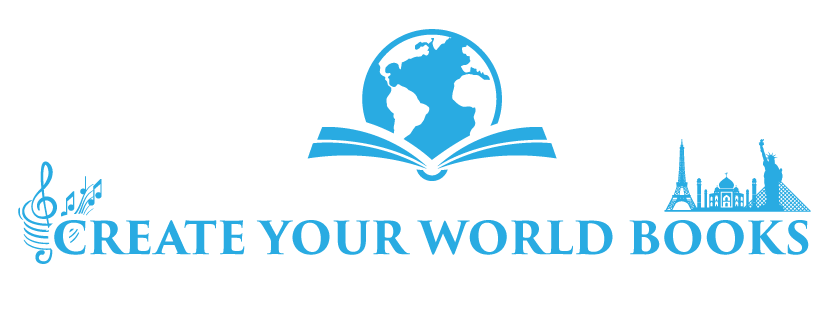I learned more Arabic in 10 minutes with a $1 tea than from 1.5 hours of Rosetta Stone ($500).
(This review shows the negative and positive elements of the Rosetta Stone software for Arabic. I have a list of free and paid resources for learning Arabic.)
Disclaimer: In 2003, nine years prior to writing this review, I took an intensive three-week Arabic class and I learned to read and write in Arabic and I could say some basic expressions. However, I could only read very slowly and not well. I remember very little from that class. I’ve also traveled in the Arab world and know some words, but I cannot form any sentences. I didn’t start this Arabic lesson from Rosetta Stone completely from zero. In fact, if I hadn’t had any previous Arabic exposure, my first lesson with Rosetta Stone would have been an even worse disaster as I wouldn’t have understood anything.
For the last two years, I’ve had the most expensive item in my closet standing by itself and never being touched, unless I needed to move it aside to get something else.
Was this a ball gown?
A pair of Manolo Blanik shoes?
No, anyone who has seen my videos can attest to my modest attire and footwear.
Answer: Rosetta Stone’s Total E Arabic edition.
I’m a language enthusiast who has had a free review edition of a $500 language learning software in my closet for two years.
Some friends told me I should sell it. But since Rosetta Stone graciously gave it to me for free, I deemed it unethical to turn around and make some money selling it on EBay.
If I am so interested in languages, why did it take me two years to try it out?
When I went to the Rosetta Stone demonstration in San Francisco in October 2010, the executives from the company had me try out their Swedish version. In the hour trial session, I saw a picture with a word written out and I heard the word sounded out by a recording on the computer. After seeing a couple of words and photos and hearing the corresponding audio, the software showed me four photos and one word to see if I could match the word, both spoken and written, with the correct photo. Some of the Swedish words reminded me of words I knew in English or German (I don’t speak German but I know some words). I just solved the puzzle by using what I knew from German and English, but not because the program had successfully taught me the words. The executives who were leading me through the trial were impressed with how well I performed and understood their system. I did well in the trial but I retained no Swedish words. I figured out the pattern the software was presenting but that’s it. No language learning. I wouldn’t even be able to say “Hello” to the Customs Officer upon arriving at the Stockholm Airport.
Therefore, the thought of staring at my computer to learn a language repelled me and I let the software stay in my closet for two years. Every time I had to reach on the top shelf of my closet to get something, I saw the colorful yellow Rosetta Stone box and was reminded of my free Arabic lesson.
My “date” with Rosetta Stone
According to the New York Times on June 20, 2012, Rosetta Stone spent $98.5 million in advertising. Yes, that’s right 98.5 million US dollars on telling us all that you can learn languages from their yellow box. With an advertising blitz like this, you can guess that one of the most common questions I get is: “What do you think of Rosetta Stone?”.
Although advertising campaigns don’t mean that the product is good or effective, just take McDonalds and its excellent ads as an example, I knew I’d have to finally sit down and try out the program and see if it was any better than the Swedish trial session in San Francisco.
I arranged a “date” with Rosetta Stone one Saturday evening in my backyard. I reclined in my lawn chair, turned on the outside light, and entered into my durs al arabi (Arabic lesson).
TECHNICAL DIFFICULTIES
The date/lesson started out with two hours of technical problems due to Rosetta Stone’s software and faulty USB headphones with microphone. This was not a good way to start a relationship.
After installing the first CD with Rosetta Stone Total E onto my laptop, I had to install an update. However it wasn’t just one update. In order to get to the screen that allowed me to proceed to installing the Arabic Level One CD, I had to re-install the update three times. Yes, I had to repeat the same procedure THREE times.
* Total Time to get the program and Arabic CD on my computer: two hours.
* Arabic learned in the two hour installation: ZERO.
Rosetta Stone includes a pair of USB headphones with a microphone to work with their voice recognition technology. I had to say something into the microphone to check that the software could detect sound and recognize my voice. The software heard me but I couldn’t hear the software. The microphone worked but the headphones didn’t. It was like a date where the person I was meeting with could hear me but I couldn’t hear him. Pointless. I used my cheap headphone and microphone instead.
ROSETTA STONE REVIEW: “LEARNING” ARABIC
Problem #1 : Which Arabic am I learning?

Nowhere on the colorful Rosetta Stone Arabic packaging was there any mention of which Arabic I’d be studying. Nor did the software indicate whether I’d be embarking on Lebanese dialect or classical Arabic. The package should clearly state what the customer is buying. Over 20 countries have Arabic as their main language. There are huge differences in the Arabic used in Morocco and the one heard in Saudi Arabia. Actually, Arab speakers tell me that North African Arabic is unintelligible to those in the Persian Gulf. Modern Standard Arabic (MSA or al-fuṣḥā, الفصحى) is the Arabic used for news broadcasts and is understood by educated people over the Arab world.
Problem #2: Where is Arabic spoken?
Language textbooks always have a map of the country or countries where the target language is a primary or secondary language. Rosetta Stone, despite all of its expensive and colorful photographs, doesn’t show on a map where I could practice the language I will learn using its product. You could argue that someone who has decided to pay $500 should already know where the language is spoken, but part of language learning is cultural exposure. Let me correct myself, language acquisition IS culture. Not all language students will know where the 20 plus Arab speaking countries are.
Problem #3: The photos are generic, not specific to the Arab world.
I didn’t choose Arabic so I could learn the language looking at a picture of a Japanese geisha or an Western woman drinking orange juice from a tall glass.


Part of what makes a good language textbook engaging are the photographs showing the sites, foods, clothing, architecture and history of the country or country where the language is spoken. This type of content can even keep the most bored language student somewhat engaged. But Rosetta Stone has NO cultural content.
Teach me the colors by showing me a spice market in a souk (open market).
Show me the differences between the mouth watering baklava made in Damascus vs the kind baked in Algeria.
Post photos of the famed nightlife in Beirut and teach me the words for smile, fun, dancing, drinking, walking the Corniche (coastal road), discos, bars, cafes, restaurants and the foods and drinks people typically have on a night on the town with friends.
I’m more likely to remember the word for tea if I see a photo that shows me how people drink tea with mint leaves in East Jerusalem than if I see some generic photo of someone drinking tea anywhere in the world.
For $500, the customer should expect language and culture specific content.
Learning a language without culture, music, media, food, clothing and information about the artistic, archeological and architectural treasures of the countries where the language is used is boring. It dilutes the language to some mathematical formula that you need to learn. My high school chemistry teacher said about chemistry equations, “learn the formula and then plug and chug”. Translation from American slang: learn the formula, insert the values for the variables and get your answer.
If you just plug and chug with a foreign language, you come out sounding like a computer program with no emotion or connection to the language and culture.
This is exactly what Rosetta Stone feels like: a cookie-cutter bingo game for vocabulary words generated by a computer, not humans.
If I am spending $500, I want to speak like a human, not like a computer.
Problem #4: At the start, you only hear one or two words being spoken.
As I discuss in my book, Language is Music, and share in my videos, you have to first listen to a language and then learn it. You have to hear the musicality of your target tongue to get used to its sounds, melody and rhythm.
Rosetta Stone doesn’t let you hear natural dialogue from the onset. You just hear one or two words.
Problem #5: There’s no music! There are no videos of people speaking.
When I met with the Rosetta Stone representatives in San Francisco, they were quite surprised with my question about the lack of music in their programs. They didn’t realize that music is integral to language learning. This in and of itself is reason enough to avoid this product. If the people running the company who prides itself on being the “leading language-learning software in the world” don’t know that lyrical music is KEY to language learning, then they are running a purely marketing machine and not a business founded on pedagogical principles.
Problem #6: It’s not natural.
Despite Rosetta Stone’s claim to teach you the natural way without grammar rules and vocabulary lists, their program is anything but natural. It’s not natural to learn a language by simply staring at a computer screen and speaking into a microphone, that is of course, if the microphone they provide even works. You learn a language by getting a feel for it. I felt nothing. I would have been better off watching Al Jazeera in Arabic for 1.5 hours rather than spending the time with this program.
These were the words and phrases I was supposed to learn in Lesson One:
girl, boy, girls, boys, 3 girls, 4 boys, man, woman, hello, bye, men, women, drink, eat, swim, jog, read, write, cook
How about “Good Morning”, “Good night”, “My name is”, or something more useful or a beginner? I am not learning Arabic to judge a swim meet and I don’t need to learn various forms of the plural for nouns in the first 30 minutes.
Problem #7: The lack of explanation in English (or the native language of the student) causes confusion.
Rosetta Stone uses the same software for an Italian speaker learning Arabic and for a German person speaking Arabic and for anyone else who will pay top dollar. They can do this because there are no instructions or explanations in any language for the products. They call this immersion!
This IS NOT linguistic immersion!
I was immersed all right, but just not in Arabic. I was immersed in the software strategy behind Rosetta Stone’s machine. Major difference.
This makes it easy for them to sell the product in new markets. What’s easy for them for market expansion is a disaster for the language learner.
Explanation is needed!
Even when they do show pictures for the plural of boy, girl, women and men, it’s not clear if the word they are attempting to teach me for two boys means a “pair of boys”, “two boys” or “boys”. Because of the culturally unspecific photos, I got confused when there was a photo of several Asian women. The word sounded like “nissei” which means “Japanese” in Japanese.

I didn’t know if the word I was supposed to learn was “Japanese women” or “group of women”. You can’t copy the text and paste it into an online translator because the text appears as an image on the screen. So you are stuck if you don’t know what the word means. I made a screen shot and sent it to my friend in Egypt to explain to me. After two weeks, he didn’t respond so I took my computer to a café near my gym and asked Hisham, the Iraqi owner to decipher the images that I couldn’t understand.
A $1 tea over a $500 product

In 10 minutes, Hisham, not only explained what the images were, he also explained the grammatical rules in Arabic to make a noun plural. Indeed, there is one way to say “two” of something and another way to say there are three or more. He also showed some things on Google Translate and pointed out where Google Translate was wrong in Arabic. In the space of those 10 minutes, I also learned how to say “I am writing”, “I am reading my book”, “I am drinking tea”, “rain” and “It is raining”.
Not only did Hisham teach me more in 10 minutes than Rosetta Stone did in 1.5 hours, but my $1 freshly brewed loose leaf black tea saved me from the rain for which I was not prepared.
I understand that not everyone has someone nearby who can help them with a language. But I am using this example to show that you can learn more by speaking to a native speaker, either a paid tutor or a language exchange partner than by staring in front of your computer and shelling out $500. (See resources for paid tutors and free language exchange below.)
Because there’s no textbook or glossary with an English translation, you are stuck until you sign up for a live class with a Rosetta Stone teacher. These classes are included in the price of your product.
#8 No alphabet explanation
Since there are no explanations, there are no phonetic spellings in Latin letters. I truly think that for the very beginning, before people learn the alphabet, it makes sense to have the words written out phonetically in Latin letters.
Left to right or right to left?
But, okay, some teachers believe in the full immersion method. Fine. At least explain to people that Arabic, like Hebrew, Aramaic, Farsi and Urdu is written from right to left!
Nope. Rosetta Stone doesn’t even bother to tell you that you’ve got to move your eyes the other way. Whether they expect you to already know this or that you’ll figure it out eventually with their defective software, I don’t know. But this is a huge flaw. Because it’s simply not obvious!
Even worse, there’s no explanation that some letters in Arabic are written differently in the beginning, middle and end of words. I only understood this because I had previously studied Arabic and Hebrew.
In the spelling section, you hear a letter sounded out and the word it’s in and then you are supposed to choose which letter is the right one. You have a choice of two letters. After getting it wrong a couple of times, I remembered from my Arabic lessons nine years prior that some letters changed form. But this was not made clear in the lesson. Nor is it intuitive for someone from a Latin or Cyrillic based language that a letter would look different based on it’s position in the word. A simple explanation would make this clear. When I was studying Arabic and Hebrew, many students struggled with these letters, even when the instructor had explained their multiple appearances. I can only imagine how nerve wrenching this would be to a beginner Rosetta Stone student who has no clue about these rules.
Problem #9: I learned one word in an hour and a half.
I was able to play the games and get a good score, around 88% but I only retained one new word for the word “girl”.
I could have found Arabic news videos online, I could have listened to Arabic songs and found their transliterations and translations online and studied the lyrics. I could have even taken an Arabic-English dictionary and studied the words for 1.5 hours. Even reading grammar rules and conjugation charts in the most boring of textbooks with no photos, audio or media component would have been more effective than my Saturday night date with Rosetta Stone.
After all of this, you’re probably wondering what could she possibly say that is positive about Rosetta Stone?
One positive aspect
Rosetta Stone is fine for someone reviewing but not for someone who actually is starting from zero. They have games like bingo, where you pick the right word based on what you hear and see. This can be a fun game to play or for a teacher to give to students to review material learned in class or in a textbook or some other learning platform.
—-
I didn’t try out the online games or lessons with native speakers because I was so frustrated with the 3.5 hours I had wasted in installing the software and learning nothing from the first lesson. Had I paid the $500, I would have immediately returned the product.
My next Saturday night was at the Brazilian Yemanja (goddess of the water) festival at the beach. Did I learn Arabic there? No, but I got to dance and practice my Portuguese. And the Saturday night after that, I went to another Brazilian music party.
Of course, I understand that I will not become fluent in Arabic with my mini-lessons over tea, I will have to study the grammar and alphabet, either alone with a book, or via an online class or in a classroom situation or with an online tutor.
I’ve prepared a list of free and low-cost online resources to learn Arabic.
Photo credit for the Arabic tea photo.
Photo credit for the Arabic tea glass photo.















Maybe we could convince major bookstores to stop carrying them.
Andrew, as long as people buy them and don’t return the product, bookstores will yield prime shelf space to the product. But if people return the product because it doesn’t work, bookstores will see that it’s not worth carrying the product, especially as so many bookstores are closing in the US.
I was supicious of their current campaign showing people who had supposedly learned a language. I bet they are monolingual actors.
With $98.5 million for advertising, Rosetta Stone has its pick of actors.
Your assessment of the Arabic program is the same as mine was about 11 years ago, when Rosetta was still in its first edition.I won a copy in a contest Rosetta Stone was having. It was a 2 lesson program. In fact, there were so many problems with the language program, I’m surprised they didn’t address them then. One of the first problems was the writing aspect. You hit the nail on the head with that. And the cultural ineptitude. Especially DOG. You do not want the word DOG in the language learning cycle any more than you want PIG or WINE. Yet, there they were. And DANCING!
The most tone-deaf language program ever concocted and foisted upon the gullible. We sampled the Vietnamese product and the only word I remembered was the word for Airport.
Your review was spot on. I was very excited to get the software from Rosetta Stone and opened the first Arabic lesson and was completely lost… I thought I was crazy because all the hype about how this software is amazing… however it’s a complete rip off and I will be returning it asap.
Susanna,
This is my first visit to your site and I have really enjoyed what I have seen of it thus far! Kudos! I got here via the 3 polyglot interview you did with Richard and Luca. It was entertaining and informative. Congrats!
I read your thoughts on Rosetta Stone (Arabic) and, for the most part, I agree with you.
I decided to use RS to polish/expand the French that I learned using Michel Thomas and Pimsleur. To be honest with you, I find that it’s been rather helpful for me. Mind you, I am only halfway through Level 3, but… I feel as though it is making certain concepts more concrete in my mind. Mind you, I think that RS is a “decent” supplement. Basically, I think that if one has done Michel Thomas and Pimsleur for a given language, let’s say… I think that RS would be a p-r-e-t-t-y decent supplement to solidify/expand whatever grasp one has of of a given language.
I think that RS is probably most useful as a supplemental tool for Romance Languages, but I think that it might even be an OK supplement for languages like Russian… even Chinese and Arabic…
My .02.
Chris
The biggest thing I don’t like about Rosetta Stone is that they only give you two installs. You have two computers die on you and it is over. Sure, you can call customer support and beg for another one, but I was unsuccessful in getting another one after my first computer died. Now that my second one has gone to the graveyard, I’ll see how successful I am in getting them to send me another install (which of course will only last as long as my next computer does).
You can tell you knew little about Arabic, because the problems you pointed out are what novices have issues with using Rosetta Stone. For example, not knowing what Nissaa meant, or what Arabic was being used, However, I think that helps prove your point in that the program may be difficult for novices to catch on to. I actually found the program more useful after I had studied Arabic for a few years, because I myself knew that the program was using standard Arabic, including case endings, and that it simply was a way for me to practice regularly what I already knew. It especially helps knowledge of grammar rule retention.
I bought level one of Rosetta Stone and grew bored of it within a few weeks and learned very little. I took formal classes, I’m almost done with Spanish 2 in college and I learned a LOT OF Spanish. For the money one pays for Rosetta it shocks me they have NO TEXTBOOK which would help a lot more and should be used in conjunction with the program and the book would clear any misconceptions about the interpretation of the pictures. Save your money – take a class. Rosetta Stone simply sucks.
To address #3; there is simply no Arabic culture. Wherever you turn to Arabic, that turns out to be some stinky Islam or offensive, retarded, misogynistic way of life in Arabic world. It is not attractive, and nothing attractive for the Western audience can be found.
Susanna,
I agree with you completely on the Rosetta Stone Arabic. If you don’t know what the image is, it’s hard to figure it out. What do you recommend to use to learn Arabic?
Thank you